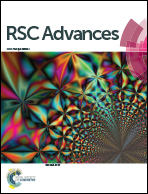Superior visible light photocatalytic performance of reticular BiVO4 synthesized via a modified sol–gel method
Abstract
Reticular BiVO4 catalysts were successfully synthesized via a modified sol–gel method. Here, citric acid (CA) was used as the chelating agent and ethylenediaminetetraacetic acid (EDTA) was used as the chelating agent and template. Furthermore, the effects of pH values and EDTA on the structure and morphology of the samples were studied. We determined that EDTA and pH played important roles in the determination of the morphology of the as-prepared BiVO4 samples. Photocatalytic evaluation revealed that the reticular BiVO4 exhibited superior photocatalytic performance characteristics for the degradation of methylene blue (MB) under visible-light (λ > 400 nm) exposure, about 98% of the MB was found to degrade within 50 min. Moreover, the degradation kinetics of MB was in good agreement with pseudo-first-order kinetics. The obtained apparent reaction rate constant kapp of reticular BiVO4 was much higher than that of BiVO4 synthesized by the citric acid sol–gel method.



 Please wait while we load your content...
Please wait while we load your content...